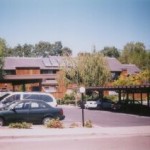Workplace Housing

Affordably Owned by not-super rich folks
Section 8 rental subsidies for generations?
Section 8 tax dollars taken from your taxed wallet to help low income households for generations?
Or
Own a home and its appreciation in the North Bay?
One time financial partnership assist to boost your toward financial independence?
FANNIE MAE
(Federal National
Mortgage Association)
1990 Blue Book National Model
CASA (Community Assisted
Shared Appreciation)
FANNIE MAE recommends emulating CASA across the nation
What is CASA?
Allows low and moderate income households to share in the benefits of homeownership in overpriced areas.
How?
The household buys in partnership with a non-profit, public benefit trust fund, foundation or public agency.
Why?
Allows civil servants, teachers, nurses, small businessman to live in their work community, share great American dream of equity appreciation thereby building true community and reducing traffic and environmental pollution caused by forced commutes to distant housing.
Town house, condo, starter home costs $225,000.
3 person household = $40,000 income, good credit
Saved, family gift = $20,000 down
Qualifies $125,000 9% mortgage, $1,0005 monthly
Sales price $225,000
Less down & mortgage -(20,000+125,000)
Shortfall $80,000
$80,000 = from Affordable Ownership Fund (CASA)
Funded from?
MCFoundation Affordable Ownership Trust Fund
Redevelopment Agency Fund
Open Space District or replica
Marin’s Most Pressing Need Trust Fund
Developer in-lieu fees…
Combination of above
How repaid?
Deferred principle and interest 2nd mortgage
“Sleeping Second Mortgage”
How is financial independence gained by homeowner?
Homeowner shares proportionally in appreciation.
20,000 down + 125,000 mortgage = Homeowner’s share
$225,000 Sales Price Unit Sales Price
$145,000 = 65% homeowner’s share
$225,000
Homeowner will live in home, maintain and care for it, take tax write-offs, and if and when he/she sells it reap 65% of the appreciation.
How is solvency of CASA (Workplace/Affordable Ownership Housing Fund) maintained to continue program?
CASA contributed $80,000 toward purchase price.
$80,000 = 35% CASA’s share
$225,000
At sale CASA will receive 35% of appreciation which will return to the CASA fund to provide funds to repurchase that same or another house for the low/moderate income household seeking affordable ownership housing at that time.
X years later the CASA assisted buyer sells
Selling Price = $400,000
Less original costs -225,000
Appreciation $175,000
CASA fund receive 35% or $61,250
of appreciation/contingent interest to assist next low/moderate income buyer.
Homeowner receives 65% of the appreciation or $113,750 to buy another home.
General Plan Update
San Rafael should add this to Housing Element as:
- Corner stone of its affordable housing program.
- In-lieu fee contribution to CASA Fund should be option available to developers rather than just prescribed %age of low income units in their developments
- Benefits employers whose employees want to own and not commute long distances.
- Adds option to developer’s available tools.
- Workers prefer owning to renting.
- Builds community pride.
Fund this program via:
- Budgeting it as line item
- Transferring some Redevelopment Agency funds to it
- Proactively pressing the Marin Community Foundation to fund it
- Educating the community on the more pressing need to fund it versus such less needed well-funded programs such as the Open Space Acquisition Fund.
The dearth of affordable housing – and the traffic congestion it causes – is Marin’s most pressing need – not more open space.
The family is best educational source children will ever be exposed to.
The house you live in is the schoolhouse you’ll learn the most from.
Every family should have the opportunity to proudly own a home near where they work.
To build strong families and the benefits they bring to the community, this should be a priority program in every General Plan and every endowed public benefit agency in pricey Marin.
3 person household = $40,000 income, good credit
Saved, family gift = $20,000 down
Qualifies $125,000 9% mortgage, $1,0005 monthly
Sales price $225,000
Less down & mortgage -(20,000+125,000)
Shortfall $80,000
$80,000 = from Affordable Ownership Fund (CASA)
Funded from?
MCFoundation Affordable Ownership Trust Fund
Redevelopment Agency Fund
Open Space District or replica
Marin’s Most Pressing Need Trust Fund
Developer in-lieu fees…
Combination of above
How repaid?
Deferred principle and interest 2nd mortgage
“Sleeping Second Mortgage”
How is financial independence gained by homeowner?
Homeowner shares proportionally in appreciation.
20,000 down + 125,000 mortgage = Homeowner’s share
$225,000 Sales Price Unit Sales Price
$145,000 = 65% homeowner’s share
$225,000
Homeowner will live in home, maintain and care for it, take tax write-offs, and if and when he/she sells it reap 65% of the appreciation.
